60 Vintages
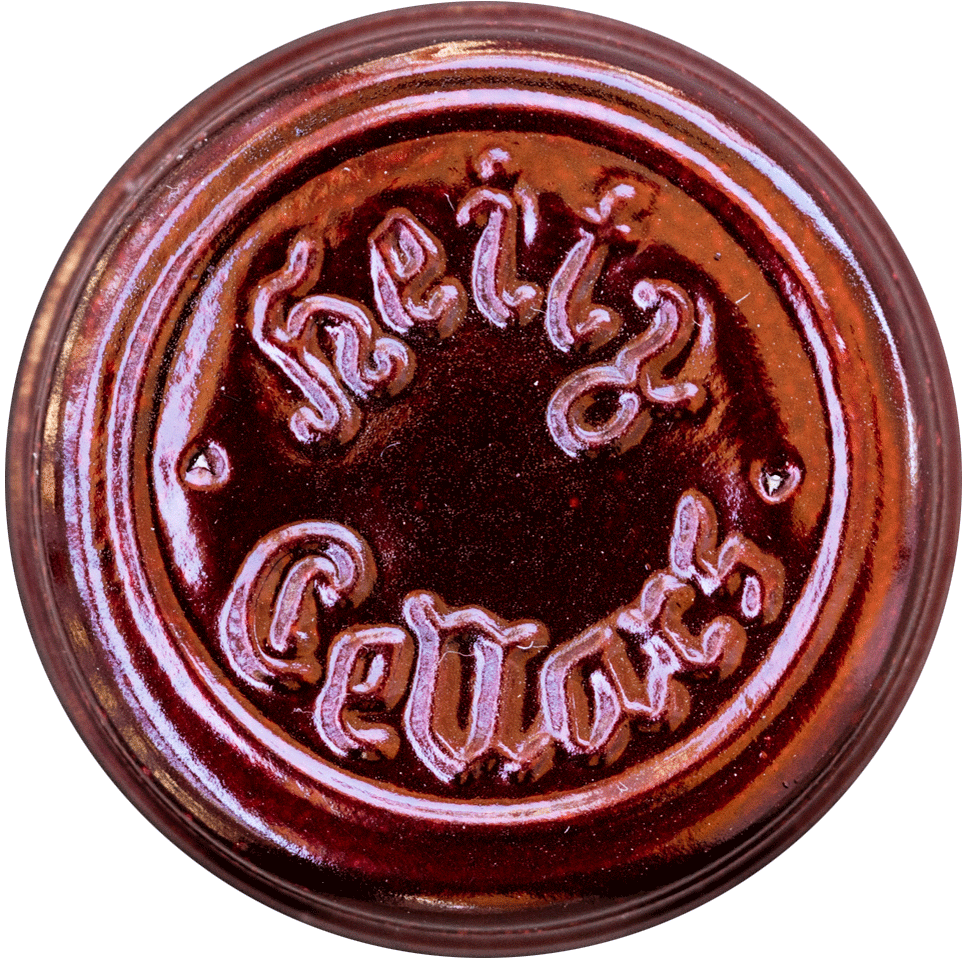
Vintage after vintage, tending our Napa Valley vineyards, we translate the place and time into a bottle of wine. Each vintage has a story to tell.
1961
Heitz Cellar was founded by Joe and Alice Heitz after acquiring an eight acre vineyard and winery, south of St. Helena on Highway 29, which would become home to the Heitz Cellar tasting room for the next fifty-seven years.
A short crop and the passage of time have made these wines extremely difficult to come by. When found, however, the wines are delicate and bright, yet fully mature. The vintage was characterized by extreme spring frosts, a steadily warm summer, and rain during harvest.
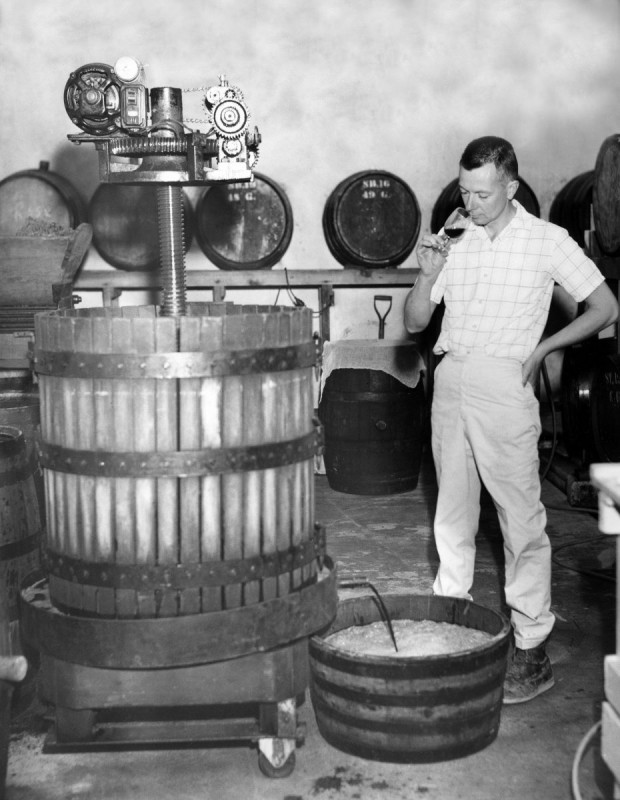
1961 Cabernet Sauvignon
1961 Pinot Chardonnay
1961 Pinot Noir
1961 “Cellar Treasure” Tawny Port
1962
This cold, late-ripening vintage produced wines that are now fleeting, delicate and fully mature. The best examples can still be delicious. The second year in a row of springtime frost resulted in another short vintage. Overall the year was quite cool, and the harvest was very late. The vast majority of 1962 Napa Valley wines are past their peaks now, but a rare few still offer a core of age-sweetened fruit and gentle woodsy aromas.
1962 Cabernet Sauvignon
1962 Pinot Chardonnay
1962 Pinot Chardonnay, Lot C-22
1962 Ruby Cabernet
1962 Pinot Noir
1962 Pinot Noir, Lot N-21
1963
A troublesome vintage, 1963 saw both a heat wave and significant rains before harvest. Despite the difficult conditions, however, a good portion of 1963s are beautiful and charming even to this day.
1963 Grignolino
1963 Burgundy
1963 Barbera
1963 Pinot Chardonnay
1963 Grignolino Rosé
1963 Chablis
1963 Johannisberg Riesling
1963 Dry Sherry
1963 “Cellar Treasure” Port
1963 Cabernet Sauvignon
1963 Pinot Noir, “special lot”
1963 Pinot Noir
1964
Joe Heitz discovered a larger piece of property in the eastern hills of St. Helena known as Spring Valley. The Heitz Cellar winemaking operation and family moved to the bucolic site, providing them with a stone cellar built in 1898, a farmhouse, and 160 acres of land, first planted to vines in 1880.
A picture perfect growing season ripened this year’s small crop beautifully. Although fully mature, many excellent 1964s can still be found that show the slightly diffuse fruit and still lively acidity of the year.
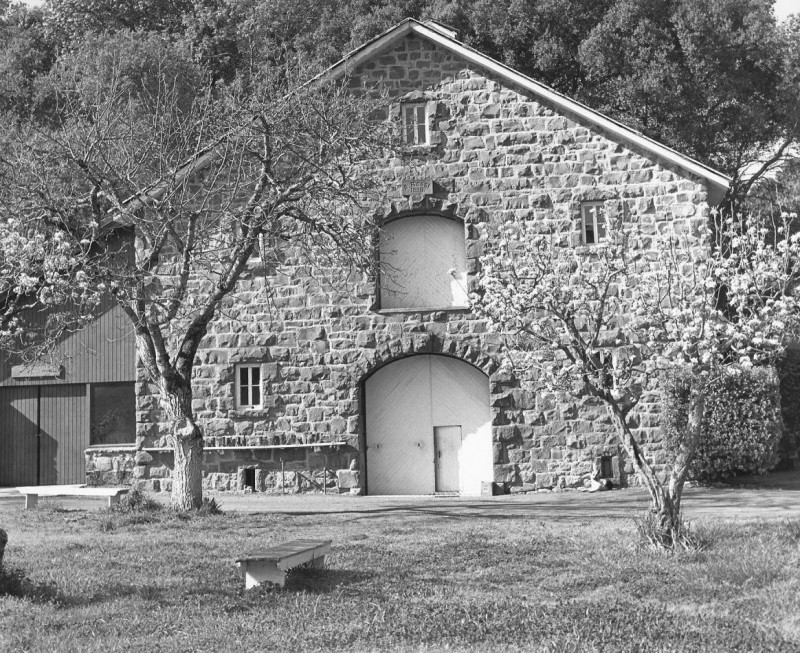
1964 Cabernet Sauvignon
1964 Johannisberg Riesling
1964 Chablis
1965
The vintage was hot and dry, peppered by many heat spikes. The resulting wines are quite concentrated and were decadent in their youth. All but the most fragile blossom with some time in the decanter.

1965 Napa Valley Cabernet Sauvignon
1965 Grignolino Rosé
1965 Malvasia Bianca
1965 Pinot Blanc
1965 Gewurz Traminer
1965 Pinot Chardonnay
1966
After purchasing cabernet sauvignon fruit from Oakville friends Tom and Martha May in 1965, Joe Heitz decided the following year to separate their cabernet fruit from the rest of his lots and craft it as a standalone wine. It was so superior, he bottled it and put the vineyard’s name on the front label. The now iconic Martha’s Vineyard Cabernet Sauvignon was the first wine in Napa Valley to be labelled with a vineyard designation, and has been ever since the inaugural vintage of 1966.
The vintage began rather mildly but got increasingly hot as harvest approached. Crop load was below average. Despite this, the 1966 vintage of Cabernet Sauvignon for Heitz Cellar was remarkable enough to justify naming the first vineyard designated wine in Napa Valley; Martha’s Vineyard Cabernet Sauvignon.
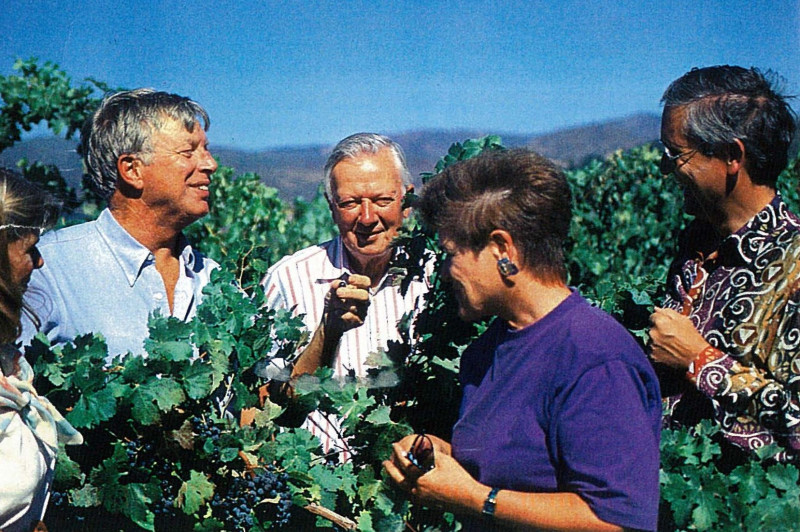
1966 Grignolino
1966 Burgundy
1966 Barbera
1966 Pinot Chardonnay
1966 Grignolino Rosé
1966 Chablis
1966 Johannisberg Riesling
1966 Dry Sherry
1966 Napa Valley Cabernet Sauvignon
1966 Brut Champagne
1966 Extra Dry Champagne
1966 Angelica
1966 Sparkling Malvasia Bianca
1966 Sparkling Grignolino Rosé
1966 Pinot Blanc
1966 Martha’s Vineyard Cabernet Sauvignon
1966 Pinot Noir
1967
A difficult year that resulted in delicate wines. Spring set a large crop, and a mild-to-cool growing season provided only moderate ripeness.
1967 Grignolino
1967 Burgundy
1967 Barbera
1967 Chablis
1967 Dry Sherry
1967 Brut Champagne
1967 Extra Dry Champagne
1967 “Cellar Treasure” Tawny Port
1967 Sparkling Malvasia Bianca
1967 Sparkling Grignolino Rosé
1967 Pinot Chardonnay
1967 Grignolino Rosé
1967 Johannisberg Riesling
1967 Martha’s Vineyard Cabernet Sauvignon
1968
The weather was warm and steady throughout the entire growing season and the wines are concentrated, robust, and consistently excellent.
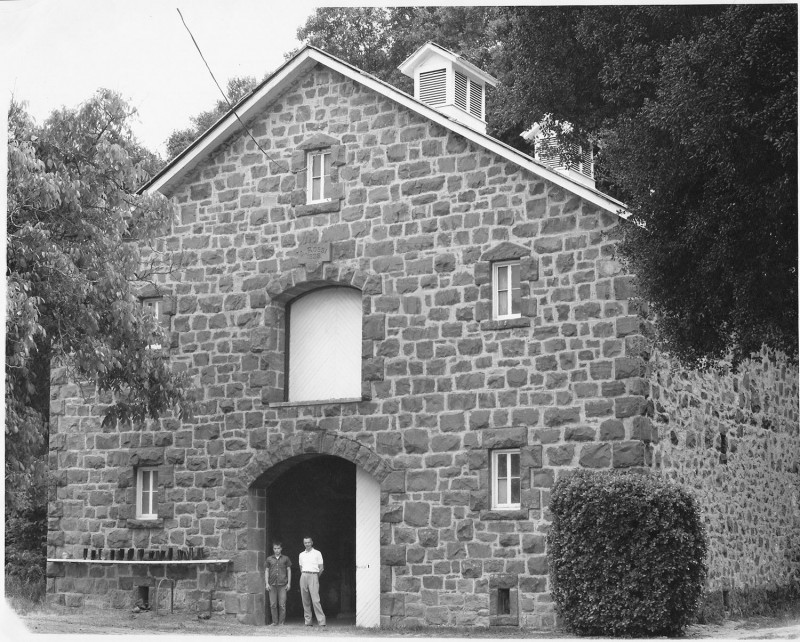
1968 Sparkling Malvasia Bianca
1968 Sparkling Grignolino Rosé
1968 Chablis
1968 Napa Valley Cabernet Sauvignon
1968 Barbera
1968 Burgundy
1968 “Cellar Treasure” Tawny Port
1968 Dry Sherry
1968 Brut Champagne
1968 Extra Dry Champagne
1968 Zinfandel
1968 Sparkling Burgundy
1968 Pinot Blanc
1968 Johannisberg Riesling
1968 Pinot Chardonnay, Lot Z-82
1968 Pinot Chardonnay, Lot U. C. V. 81
1968 Pinot Noir
1968 Martha’s Vineyard Cabernet Sauvignon
1969
The vintage was long, cool, and steady, while the wines are still dark, powerful, and impossibly youthful.
1969 Lot 62-65 Cabernet Sauvignon
1969 Chablis
1969 Zinfandel
1969 Barbera
1969 Burgundy
1969 “Cellar Treasure” Tawny Port
1969 Dry Sherry
1969 Sparkling Burgundy
1969 Brut Champagne
1969 Extra Dry Champagne
1969 Grignolino
1969 Grignolino Rosé
1969 NV Cabernet Sauvignon
1969 NV Pinot Noir
1969 Johannisberg Riesling
1969 Pinot Blanc
1969 Pinot Chardonnay Lot U. C. V. 91
1969 Pinot Chardonnay Lot 2-92-Z
1969 Napa Valley Cabernet Sauvignon, Lot C-91
1969 Martha’s Vineyard Cabernet Sauvignon
1969 Pinot Noir
1970
Understanding that quality vineyard farming was equally as important to quality winemaking, Joe Heitz began employing the skills of vineyard manager Jack Neal. Heitz Cellar’s relationship continues today with the family owned business, now known as Jack Neal & Sons, who are responsible for meticulous farming and land stewardship of over 450 acres of Heitz Cellar vineyard properties.
Long-lived wines from a small crop of very high quality wines. Spring was dramatic with both extreme frost and extreme heat, but the rest of the season was protracted and warm.
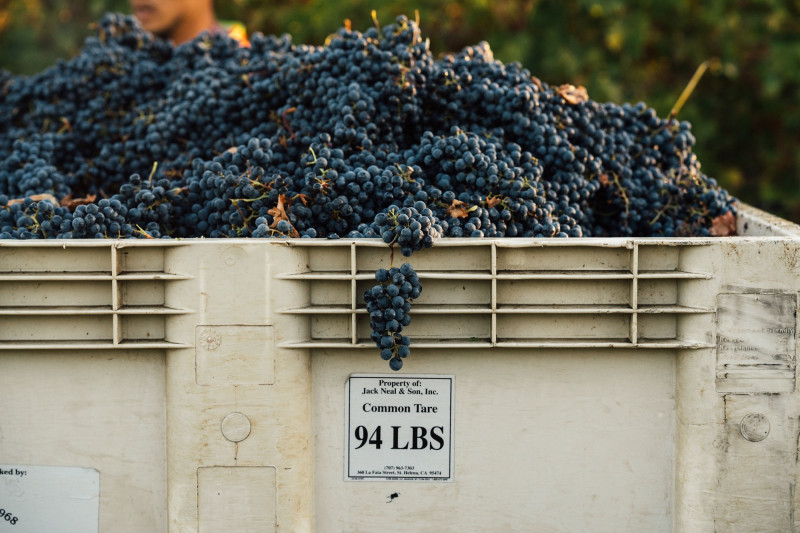
1970 NV Pinot Noir
1970 NV Cabernet Sauvignon
1970 Chablis
1970 Zinfandel
1970 Barbera
1970 Burgundy
1970 “Cellar Treasure” Tawny Port
1970 Dry Sherry
1970 Sparkling Burgundy
1970 Brut Champagne
1970 Extra Dry Champagne
1970 Grignolino
1970 Grignolino Rosé
1970 Alicia
1970 “Cellar Treasure” Angelica
1970 Johannisberg Riesling
1970 Pinot Blanc
1970 Pinot Chardonnay Lot Z-02
1970 Pinot Blanc “Lyncrest”
1970 Pinot Blanc “McCrea”
1970 Pinot Chardonnay Lot UVC-01
1970 Napa Valley Cabernet Sauvignon
1970 Martha’s Vineyard Cabernet Sauvignon
1971
A wet harvest resulted in diluted flavors. Winter and spring were cold and wet, while the cool weather continued throughout the growing season. High yields were problematic, and Napa Valley struggled against Mother Nature.
1971 Chablis
1971 Zinfandel
1971 Barbera
1971 Burgundy
1971 “Cellar Treasure” Tawny Port
1971 Dry Sherry
1971 Sparkling Burgundy
1971 Brut Champagne
1971 Extra Dry Champagne
1971 Grignolino
1971 Grignolino Rosé
1971 Alicia
1971 “Cellar Treasure” Angelica
1971 NV Pinot Noir
1971 Johannisberg Riesling
1971 Gewurz Traminer
1971 Pinot Chardonnay, Lot Z-11
1971 Cabernet Sauvignon
1971 Pinot Blanc “Lyncrest”
1971 Napa Valley Cabernet Sauvignon
1971 Cabernet Sauvignon, Lot MZ-1
1972
While 1972 has been largely seen as the disappointing vintage of the decade, Heitz Cabernets are regarded as one of the best outcomes of a difficult season. The Napa Valley was hurt by a cool and rainy year, topped off by harvest rains.

1972 Chablis
1972 Barbera
1972 Burgundy
1972 “Cellar Treasure” Tawny Port
1972 Dry Sherry
1972 Sparkling Burgundy
1972 Brut Champagne
1972 Extra Dry Champagne
1972 Grignolino
1972 Grignolino Rosé
1972 “Cellar Treasure” Angelica
1972 Zinfandel, Lot 63-69
1972 Ruby Cabernet
1972 Cabernet Sauvignon
1972 Johannisberg Riesling
1972 Gewurz Traminer
1972 Pinot Chardonnay Lot Z-21
1972 Napa Valley Cabernet Sauvignon
1972 Pinot Noir
1972 Martha’s Vineyard Cabernet Sauvignon
1973
Elegant and subtle; well-proportioned and a relief to winemakers after two difficult vintages. A protracted, cool, and steady growing season brought in even crops and a steady harvest season.
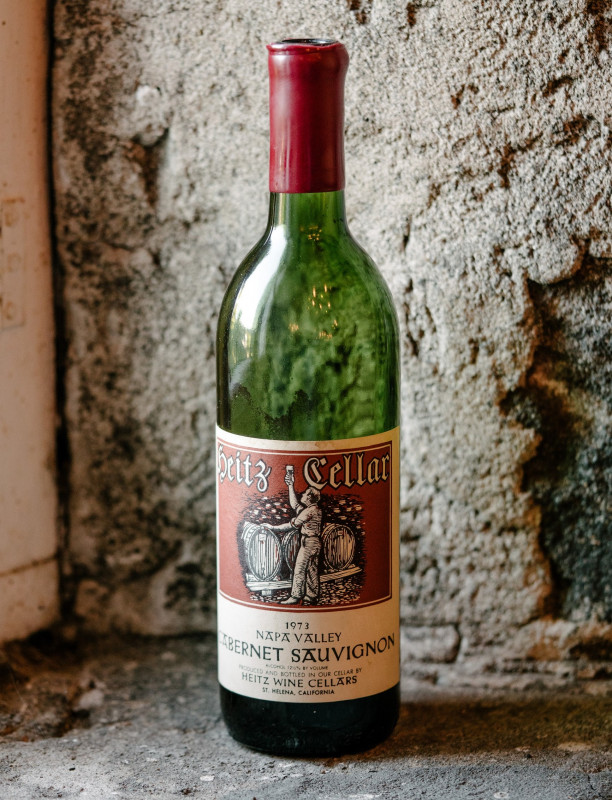
1973 Zinfandel, Lot 63-69
1973 Ruby Cabernet
1973 Burgundy
1973 Grignolino
1973 Barbera
1973 Dry Sherry
1973 “Cellar Treasure” Tawny Port
1973 Brut Champagne
1973 Extra Dry Champagne
1973 Sparkling Burgundy
1973 Zinfandel, Lot 63-69
1973 Chablis
1973 Cabernet Sauvignon
1973 “Cellar Treasure” Angelica
1973 Gewurz Traminer
1973 Johannisberg Riesling
1973 Pinot Chardonnay, Lot Z-32
1973 Pinot Noir
1973 Napa Valley Cabernet Sauvignon
1973 Martha’s Vineyard Cabernet Sauvignon
1974
David Heitz, with a new enology degree from UC Davis, officially joined the family business, working alongside his father, Joe, making wine. 1974 also marks the first commemorative label adorning the Martha’s Vineyard Cabernet Sauvignon, marking what would be the first in a series; one special label each decade. Joe and David Heitz could not have predicted the acclaim and future legendary status that the 1974 Martha’s Vineyard Cabernet would achieve. As now one of the most famous wines of California, the 1974 vintage has garnered world-wide recognition, named the Top 100 Wines of the World, and continues to be coveted by wine collectors around the globe.
An exceptional vintage; expressive, intense and full-blown. The large crop matured slowly until several heat spikes during harvest pushed ripeness across the finish line.
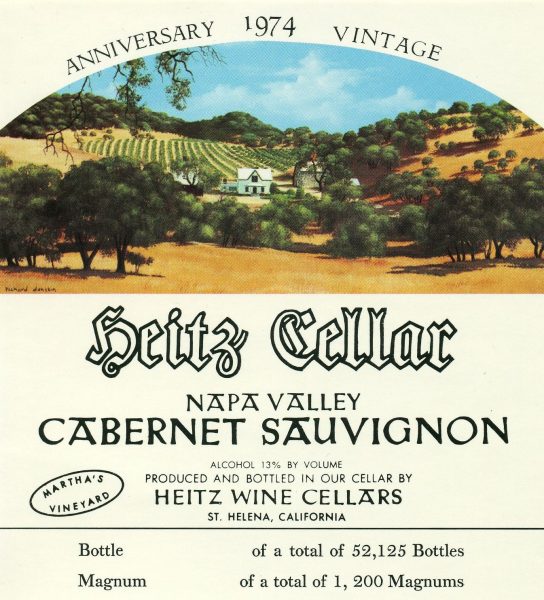
1974 Chablis
1974 Grignolino
1974 Barbera
1974 Burgundy
1974 Dry Sherry
1974 “Cellar Treasure” Tawny Port
1974 “Cellar Treasure” Angelica
1974 Brut Champagne
1974 Extra Dry Champagne
1974 Sparkling Burgundy
1974 Grignolino Rosé
1974 Zinfandel
1974 Pinot Noir, Lot 1970-71
1974 NV Pinot Chardonnay
1974 Pinot Chardonnay, Lot Z-41
1974 Gewurz Traminer
1974 Johannisberg Riesling
1974 Pinot Noir
1974 Martha’s Vineyard Cabernet Sauvignon
1974 Cabernet Sauvignon, Lot N.V. 46
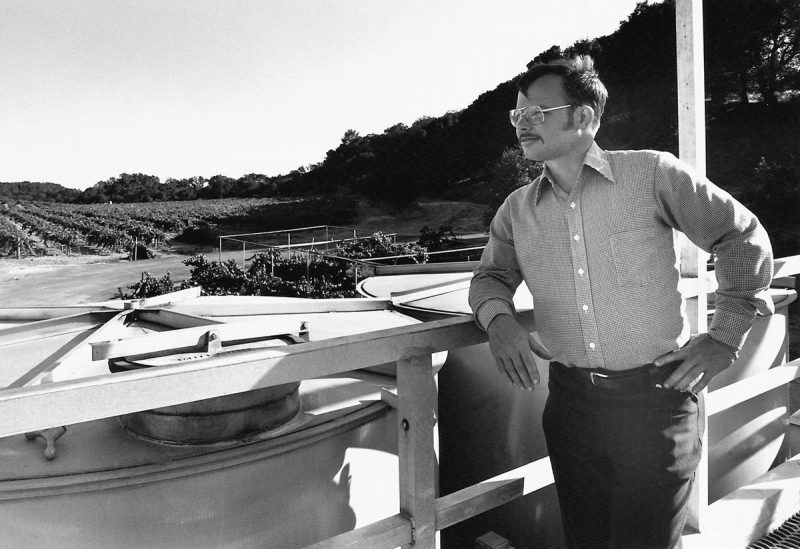
1975
Dry, warm weather throughout the summer marked the official beginning of a drought. It was to last for two full years, but growers were caught off guard in 1976. The vines were pruned for a normal crop, and the dry weather soon placed them under stress conditions. The berries were small and sugar levels soared by late August, resulting in concentrated fruit with low yields.
1975 NV Pinot Chardonnay
1975 Chablis
1975 Zinfandel
1975 Barbera
1975 Pinot Noir, Lot 1970-71
1975 Grignolino
1975 Burgundy
1975 Dry Sherry
1975 “Cellar Treasure” Tawny Port
1975 “Cellar Treasure” Angelica
1975 Brut Champagne
1975 Extra Dry Champagne
1975 Grignolino Rosé
1975 Johannisberg Riesling
1975 Martha’s Vineyard Cabernet Sauvignon
1975 Fay Vineyard Cabernet Sauvignon
1976
A monumental year in the history of Napa Valley thanks to the famous Judgement of Paris. Long established Bordeaux wines were matched against the New World wines of California in a blind tasting. Heitz Cellar’s 1970 Martha’s Vineyard Cabernet Sauvignon was among the list and placed 7th. In combination with the success of the other California wineries, Napa Cabernet Sauvignons were put in the world-wide spotlight and became instantly respected.
Dry, warm weather throughout summer marked the beginning of two year drought. Vines were placed under stress from the dry weather and berries were small, with natural sugars high by August. Rutherford and Oakville appellations were more moderate and Heitz Cellar wines were among the few standouts of the vintage.
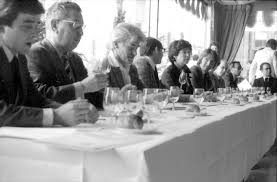
1976 Chablis
1976 Zinfandel
1976 Barbera
1976 Pinot Noir, Lot 1970-71
1976 Grignolino
1976 “Cellar Treasure” Tawny Port
1976 “Cellar Treasure” Angelica
1976 Brut Champagne
1976 Extra Dry Champgane
1976 NV Pinot Chardonnay
1976 Burgundy
1976 Grignolino Rosé
1976 Fay Vineyard Cabernet Sauvignon
1976 Martha’s Vineyard Cabernet Sauvignon
1976 Bella Oaks Cabernet Sauvignon
1977
With vines pruned for a low crop in anticipation of a second drought year, most vines carried a small crop and vineyards went through the warm, occasionally hot summer weeks in reasonably good shape. Irrigation was widely practiced avoiding over-stressing vines. The North Coast experienced several light rain showers which in retrospect proved beneficial to the small, dehydrated fruit. As a result of this harvest rain, Cabernet was revived and over the next ten days to two week the berries returned to a better balance of juice to skins and softer skins. Many of the finest wines were made from vineyards picked in late October.

1977 Grignolino
1977 Barbera
1977 Zinfandel
1977 Burgundy
1977 “Cellar Treasure” Angelica
1977 “Cellar Treasure” Port
1977 “Cellar Treasure” Sherry
1977 Extra Dry Champagne
1977 Brut Champagne
1977 Grignolino Rosé
1977 Johannisberg Riesling
1977 Fay Vineyard Cabernet Sauvignon
1977 Napa Valley Cabernet Sauvignon
1977 Martha’s Vineyard Cabernet Sauvignon
1977 Bella Oaks Cabernet Sauvignon
1978
A wet spring created concern about early botrytis, but the wished-for warm weather followed bloom. From then on was a classic even ripening season with a heat wave arriving just before the harvest began. Harvesting was frantic, and some grapes became over-ripe. But the crop size was large enough to make up for two drought years.
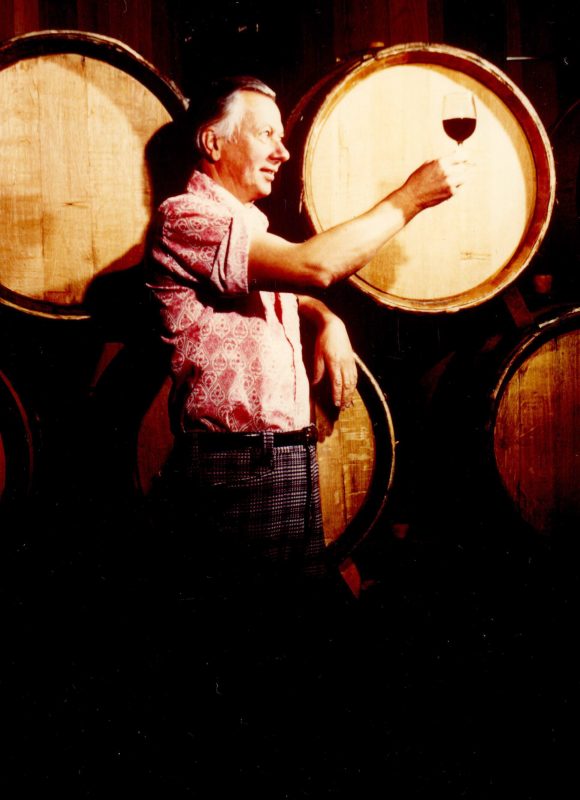
1978 Grignolino
1978 Barbera
1978 Zinfandel
1978 Burgundy
1978 “Cellar Treasure” Angelica
1978 “Cellar Treasure” Port
1978 “Cellar Treasure” Sherry
1978 Extra Dry Champagne
1978 Brut Champagne
1978 Grignolino Rosé
1978 Pinot Chardonnay
1978 Chablis
1978 NV Cabernet Sauvignon
1978 Pinot Noir
1978 Sweet Johannisberg Riesling
1978 Fay Vineyard Cabernet Sauvignon
1978 Martha’s Vineyard Cabernet Sauvignon
1978 Napa Valley Cabernet Sauvignon
1979
An under-appreciated vintage in which a cool season that began with high expectations ran up against heat spikes in July and rain showers around the harvest. Quality varied widely, with some of the reds picked before the rains, and the rest harvested well into October. Overall, the vintage yielded Cabernets that were slightly tight and austere but long-lived.
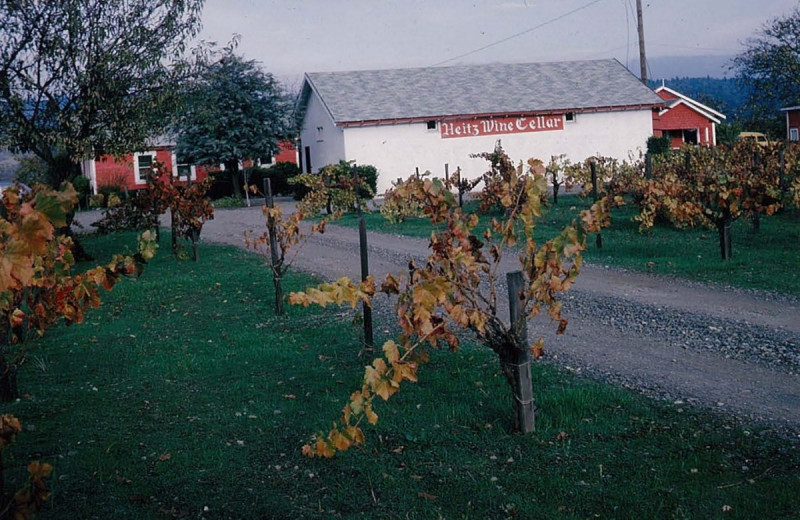
1979 NV Cabernet Sauvignon
1979 Grignolino
1979 Zinfandel
1979 Barbera
1979 Burgundy
1979 “Cellar Treasure” Angelica
1979 “Cellar Treasure” Port
1979 “Cellar Treasure” Sherry
1979 Extra Dry Champagne
1979 Brut Champagne
1979 Grignolino Rosé
1979 Chablis
1979 Johannisberg Riesling
1979 Pinot Noir
1979 Gewurz Traminer
1979 Sweet Johannisberg Riesling
1979 Pinot Noir
1979 Napa Valley Cabernet Sauvignon
1979 Martha’s Vineyard Cabernet Sauvignon
1980
A wet winter gave way to a cool early season. The bloom period was smooth, but it was unusually long, lasting over a month. The season then turned unusually cool and foggy with growers wishing for a warm spell. The long-awaited heat spell arrived in September to allow the fruit to develop higher sugar content while holding decent to good acidity. The heat continued though, and Cabernet clusters were a mix of ripeness. However, many winemakers overcame these problems and the best reds were ripe and balanced, showing their varietal character.
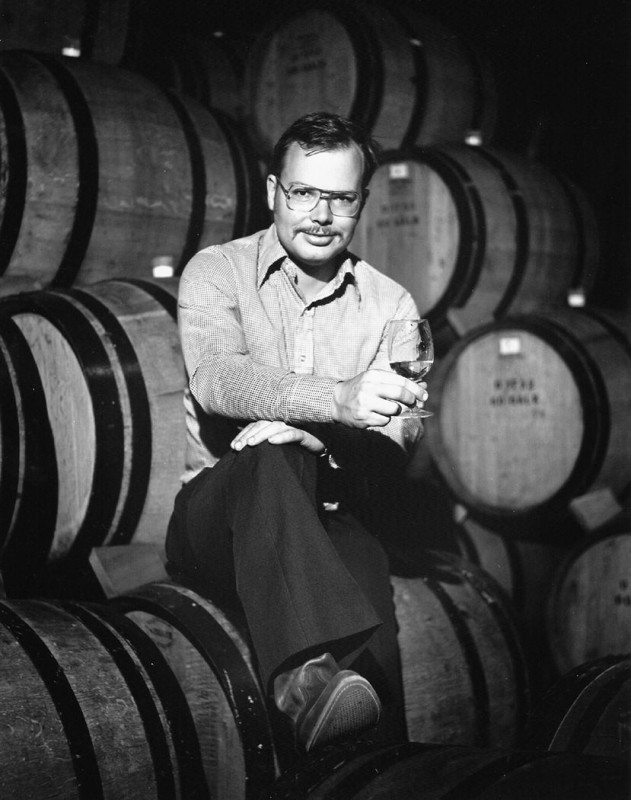
1980 Grignolino
1980 Zinfandel
1980 Barbera
1980 Burgundy
1980 “Cellar Treasure” Angelica
1980 “Cellar Treasure” Port
1980 “Cellar Treasure” Sherry
1980 Extra Dry Champagne
1980 Brut Champagne
1980 Grignolino Rosé
1980 Chablis
1980 Fay Vineyard Cabernet Sauvignon
1980 Johannisberg Riesling
1980 Chardonnay
1980 Napa Valley Cabernet Sauvignon
1980 Bella Oaks Cabernet Sauvignon
1980 Martha’s Vineyard Cabernet Sauvignon
1981
After an intense heatwave, an early harvest was in full swing by mid-August, with reduced crop levels in Napa and Sonoma. Early overviews of a quick-maturing vintage were soon modified, and this much misunderstood vintage eventually gave wines that age much better than expected. Napa Valley Cabernets revealed a supple texture, but with solid varietal character, and surprising balance.
1981 NV Cabernet Sauvignon
1981 Chablis
1981 Barbera
1981 Burgundy
1981 “Cellar Treasure” Angelica
1981 “Cellar Treasure” Port
1981 “Cellar Treasure” Sherry
1981 Extra Dry Champagne
1981 Brut Champagne
1981 Grignolino Rosé
1981 Chardonnay, Napa Valley
1981 Zinfandel
1981 Chardonnay “Heitz Vineyards”
1981 Napa Valley Cabernet Sauvignon
1981 Bella Oaks Cabernet Sauvignon
1981 Martha’s Vineyard Cabernet Sauvignon
1982
An odd year with an extremely wet winter and spring. Vines set a larger than normal crop and after a cool June and July, the summer warmed up and vines were working hard to mature the large yield. Two rainstorms plumped the berries on the over-cropped vines. Thinning vines proved a success as did waiting for better weather in October to harvest. The style of those successes tends toward ripe, but tannic and tight Cabernets in their youth and aged slowly but evenly over time.
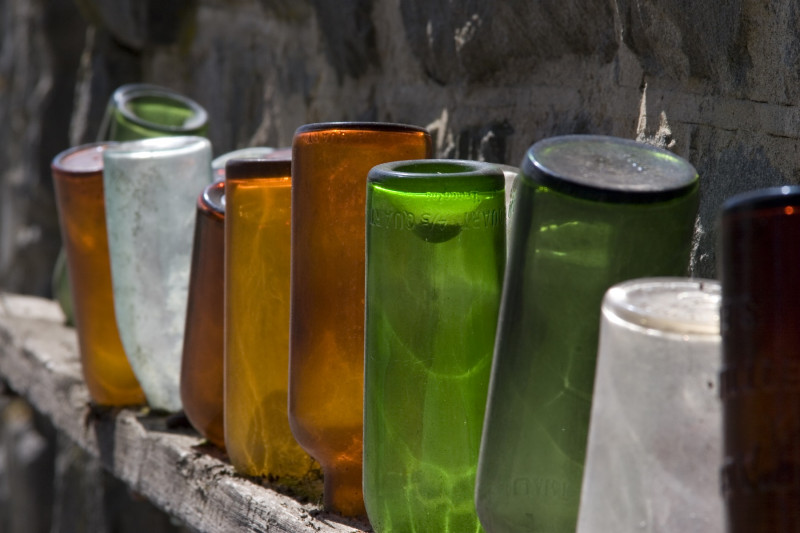
1982 Barbera
1982 Burgundy
1982 Chablis
1982 “Cellar Treasure” Sherry
1982 “Cellar Treasure” Port
1982 Extra Dry Champagne
1982 Brut Chamapgne
1982 Grignolino
1982 Grignolino Rosé
1982 Chardonnay
1982 Chardonnay “Heitz Vineyards”
1982 Napa Valley Cabernet Sauvignon
1982 Bella Oaks Cabernet Sauvignon
1982 Martha’s Vineyard Cabernet Sauvignon
1983
After beginning with normal weather through June, the season changed with frequent heat spikes and rains during harvest. Fortunately, most vineyards were harvested before the rains.
1983 Barbera
1983 Burgundy
1983 Chablis
1983 “Cellar Treasure” Sherry
1983 “Cellar Treasure” Port
1983 Brut Champagne
1983 Extra Dry Champagne
1983 Napa Valley Cabernet Sauvignon
1983 Bella Oaks Cabernet Sauvignon
1983 Martha’s Vineyard Cabernet Sauvignon
1983 Grignolino
1983 Chardonnay “Heitz Vineyards”
1984
After sourcing Cabernet Sauvignon fruit from Trailside Vineyard in the early 1980s, the Heitz family seized the opportunity to acquire the prime Rutherford site as their own in 1984. Trailside Vineyard was the start of Heitz’ venture into organic farming and was certified by CCOF in 1987. Heitz Cellar also enrolled in the Fish Friendly Farming Program and successfully undertook a large project to improve the quality and sustainability of the riparian habitat of Conn Creek along Trailside Vineyard’s western border.
This was one of those rare too good to be true vintages that was big in size and ranged from good to excellent in quality. The harvest was early due to a hot spell that kicked it off and a long period of warm weather followed to keep harvesters busy. The Cabernets responded by offering generous highly concentrated flavors, and high tannin levels. Even by California standards, the wines were huge, powerful and ultra-ripe.
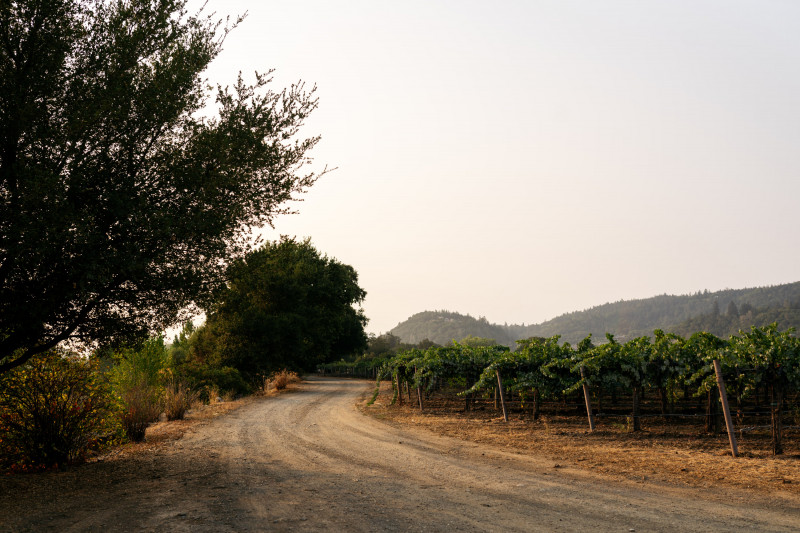
1984 Barbera
1984 Burgundy
1984 Chablis
1984 “Cellar Treasure” Port
1984 Brut Champagne
1984 Extra Dry Champagne
1984 Napa Valley Cabernet Sauvignon
1984 Bella Oaks Cabernet Sauvignon
1984 Martha’s Vineyard Cabernet Sauvignon
1984 Zinfandel
1984 Pinot Noir
1984 Grignolino
1984 Chardonnay “Heitz Vineyards”
1985
The outstanding 1985 vintage of Martha’s Vineyard Cabernet Sauvignon meant that it was deemed worthy of the second commemorative label in our history. The vintage also marked twenty years since the fateful handshake between Joe Heitz and Tom and Martha May in 1965, which is still the foundation of a long and remarkable relationship.
After experiencing one of the earliest starts through an early bud break, the season was relatively cool and ended by being one of the longest and best up to the time. The summer offered warm days, cool nights, and a cool August paved the way for a sunny September that brought the fruit to an even and incremental maturity rarely encountered in California. The fruit maturity was achieved at relatively moderate sugar levels and the acidity was textbook perfect for balance, yielding successful Cabernets. Generally ripe and supple, the wines are well-proportioned and integrated with fine tannins. At the time this was the finest vintage since 1974. With cellaring the best are displaying a refined fruitiness and elegance.
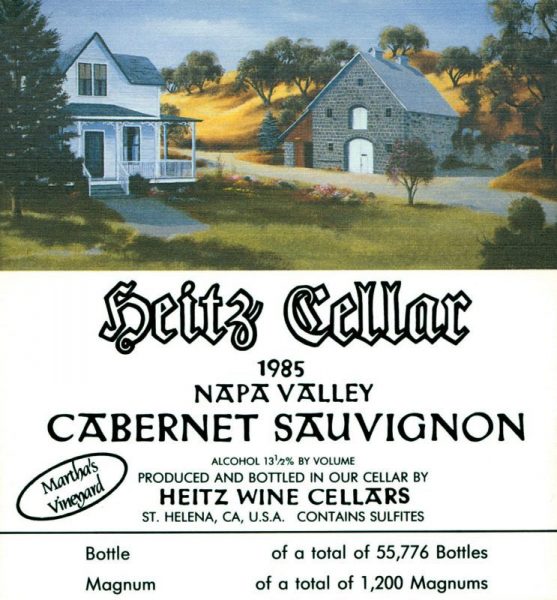
1985 Barbera
1985 Burgundy
1985 Chablis
1985 “Cellar Treasure” Port
1985 Brut Champagne
1985 Extra Dry Champagne
1985 Napa Valley Cabernet Sauvignon
1985 Bella Oaks Cabernet Sauvignon
1985 Martha’s Vineyard Cabernet Sauvignon
1985 Zinfandel
1985 Pinot Noir
1985 Grignolino
1985 Napa Valley Cabernet Sauvignon
1985 Bella Oaks Cabernet Sauvignon
1985 Martha’s Vineyard Cabernet Sauvignon
1986
Another year with early budbreak, following winter floods in Napa Valley. With a cool early season and few heat spikes, the growing season was long and seemed to resemble its predecessor up to and including a warm September. This vintage went its own way to reveal a sleek, polished fruit side and only moderate tannins. The successes were widespread and again shared by the whole of Napa Valley. Inviting in their youth, the Cabernets promised a long and beautiful future.
1986 Grignolino
1986 Chardonnay “Heitz Vineyards”
1986 Chablis
1986 Zinfandel
1986 Napa Valley Cabernet Sauvignon
1986 Bella Oaks Cabernet Sauvignon
1986 Martha’s Vineyard Cabernet Sauvignon
1987
Hot spring weather during flowering reduced the crop size and led to an early harvest. A dry summer generally yielded smallish berries and concentrated flavors. A heat wave early in the harvest spurred an early pick to avoid over ripeness.
1987 Grignolino Rosé
1987 Grignolino
1987 Chablis
1987 Chardonnay, Napa Valley
1987 Chardonnay “Heitz Vineyards”
1987 Zinfandel
1987 Napa Valley Cabernet Sauvignon
1987 Bella Oaks Cabernet Sauvignon
1987 Martha’s Vineyard Cabernet Sauvignon
1988
Always searching for the best sources to make incredible wines, Heitz Cellar acquired the extraordinary Ink Grade Vineyard atop Howell Mountain. Encompassing 745 acres of steep terrain, redwood trees, and a diversity of plant life, the rugged mountain site is fed by fresh springs that run year round. Only 245 acres were meticulously terraced and planted to vine by hand, leaving a tapestry of nature woven throughout and surrounding the idyllic location.
Another year similar to 1987’s small crop size but for different reasons. Instead of heat waves, the growing season was challenged with multiple rainstorms. Yields were small and the concentration of flavors in grapes was light.

1988 Chablis
1988 Grignolino Rosé
1988 Pinot Noir
1988 Chardonnay, Napa Valley
1988 Chardonnay “Heitz Vineyards”
1988 Grignolino
1988 Zinfandel
1988 Napa Valley Cabernet Sauvignon
1988 Bella Oaks Cabernet Sauvignon
1988 Martha’s Vineyard Cabernet Sauvignon
1989
1989 marked the inaugural vintage of Trailside Vineyard Cabernet Sauvignon. With much anticipation, it was released in 1993, joining Martha’s Vineyard and Bella Oaks as the third single vineyard wine from Heitz Cellar.
After a few years of small crops, 1989 brought large yields and was a cool growing year. The year got off to a strong start, but rain in mid and late September interrupted the harvest and caused a rush to finish picking. Overall, it was an uneven vintage for Napa Valley, depending on vineyard site and harvest dates.
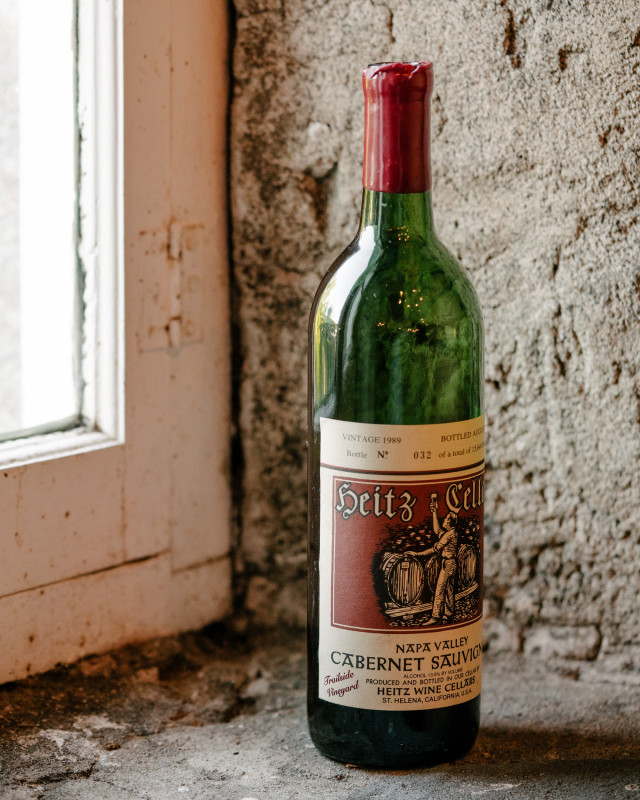
1989 Pinot Noir
1989 Ryan’s Red Table Wine
1989 Chablis
1989 Joe’s White
1989 Pinot Noir, Lot 8182
1989 “Cellar Treasure” Angelica
1989 Grignolino Rosé
1989 Chardonnay, Napa Valley
1989 Alicia
1989 Chardonnay, “Trailside Vineyard”
1989 Grignolino Port
1989 Zinfandel
1989 Napa Valley Cabernet Sauvignon
1989 Bella Oaks Cabernet Sauvignon
1989 Martha’s Vineyard Cabernet Sauvignon
1989 Trailside Vineyard Cabernet Sauvignon
1990
Crop sizes were small but produced many deeply concentrated wines that have aged well. The growing season was long and mild, with largely uneventful weather except for a bit of rain during flowering.
1990 Joe’s White Table Wine
1990 Pinot Noir, Lot 8182
1990 Chablis
1990 Ryan’s Red Table Wine
1990 “Cellar Treasure” Angelica
1990 Chardonnay, “Trailside Vineyard”
1990 Pinot Noir
1990 Chardonnay, Napa Valley
1990 Grignolino Port
1990 Zinfandel
1990 Grignolino
1990 Napa Valley Cabernet Sauvignon
1990 Bella Oaks Cabernet Sauvignon
1990 Martha’s Vineyard Cabernet Sauvignon
1990 Trailside Vineyard Cabernet Sauvignon
1991
1991 was a reverse of 1990’s small crop size, with ripe and complex berries. It was the beginning of what turned out to be a notable decade. Heavy rain in the spring brought the five-year drought cycle to a close. Temperatures during most of the summer were cooler than average but picked up in September with a series of spikes that ripened the fruit.
1991 Ryan’s Red Table Wine
1991 Joe’s White Table Wine
1991 “Cellar Treasure” Angelica
1991 Grignolino Rosé
1991 Pinot Noir
1991 Grignolino Port
1991 Napa Valley Cabernet Sauvignon
1991 Bella Oaks Cabernet Sauvignon
1991 Martha’s Vineyard Cabernet Sauvignon
1991 Trailside Vineyard Cabernet Sauvignon
1992
A temperate growing season led to uniformly rich, fleshy, supple and balanced wines. The winter saw high levels of precipitation, but 1992 is remembered mostly for two distinct heat waves in August that gave the wines their ripe, racy personalities.
1992 Ryan’s Red Table Wine
1992 Alicia
1992 Grignolino Rosé
1992 Chardonnay, Napa Valley
1992 Zinfandel
1992 Grignolino Port
1992 Napa Valley Cabernet Sauvignon
1992 Bella Oaks Cabernet Sauvignon
1992 Martha’s Vineyard Cabernet Sauvignon
1992 Trailside Vineyard Cabernet Sauvignon
1992 Grignolino
1993
Like many others in the Napa Valley, the vines of Martha’s Vineyard succumbed to phylloxera, and in 1993 Heitz Cellar began the task of replanting the vines with resistant rootstock. There would be no Martha’s Vineyard Cabernet Sauvignon for three vintages, 1993 to 1995, while the newly planted vines became established and mature.
Winter rains broke the drought and restored nutritional balance to the depleted soils. A few more raindrops fell during May’s bloom period leading to a reduced set and eventually to a smaller than normal crop. The growing season alternated between cool spells and heat spikes, but ripening was behind schedule until a few late-August heat waves increased sugar levels.
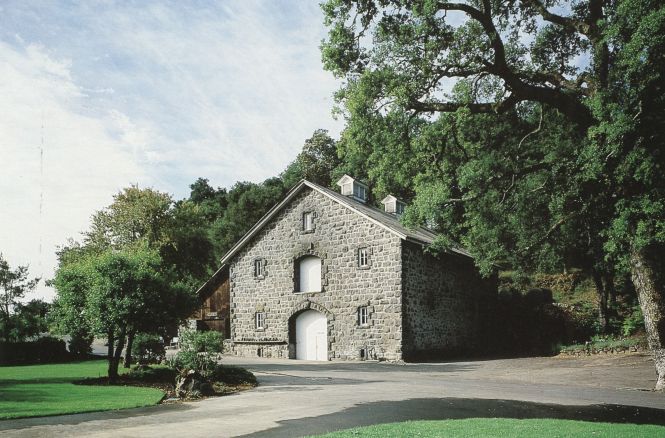
1993 Alicia
1993 Ryan’s Red Table Wine
1993 Chardonnay, Napa Valley
1993 Chardonnay, Estate Selection
1993 Zinfandel
1993 Grignolino Port
1993 Pinot Noir
1993 Grignolino
1993 Napa Valley Cabernet Sauvignon
1993 Bella Oaks Cabernet Sauvignon
1993 Trailside Vineyard Cabernet Sauvignon
1994
A mild summer followed a fairly dry winter and cool, long spring, which allowed the moderate crop load to ripen slowly and consistently. A period of very warm weather during the first half of August just after veraison brought some unevenness in coloration but thinning fruit achieved more even ripening of the grapes that remained. The long, mostly cool growing season resulted in extended hang time for the grapes, allowing fruit to develop with extraordinary flavor development and ripe tannins.
1994 Ryan’s Red Table Wine
1994 Grignolino Rosé
1994 Chardonnay, Napa Valley
1994 Zinfandel
1994 Pinot Noir
1994 Grignolino Port
1994 Grignolino
1994 Napa Valley Cabernet Sauvignon
1994 Bella Oaks Cabernet Sauvignon
1994 Trailside Vineyard Cabernet Sauvignon
1995
After the uneventful pattern of the 1994 vintage, this was a year of extremes ranging from two severe winter floods, heavy spring rains, and even a hailstorm in June. The season started late and moved along slowly. When warmth finally arrived in late June, the grapes still were maturing slowly. The summer and fall weeks returned to being mild. A warming trend in late September came along just in time to bring the fruit to ripeness levels ranging from good to ideal.
1995 Ryan’s Red Table Wine
1995 Grignolino Rosé
1995 Chardonnay, Napa Valley
1995 Zinfandel
1995 Grignolino
1995 Napa Valley Cabernet Sauvignon
1995 Bella Oaks Cabernet Sauvignon
1995 Trailside Vineyard Cabernet Sauvignon
1996
After an odd warm winter with more than normal rainfall, a pleasant spring led to early budbreak. But the cool weather encountered intermittent rain showers in May during the critical period of flowering and set. The remainder of the summer was warm, with several heat spikes speeding up veraison and eventually raising sugar. September’s brief but dramatic cooling trend allowed the grape flavors to catch up to sugar levels.
1996 Grignolino Rosé
1996 Chardonnay Napa Valley
1996 Grignolino Port
1996 Pinot Noir
1996 Zinfandel
1996 Grignolino
1996 Napa Valley Cabernet Sauvignon
1996 Bella Oaks Cabernet Sauvignon
1996 Martha’s Vineyard Cabernet Sauvignon
1996 Trailside Vineyard Cabernet Sauvignon
1997
The third vintage of Martha’s Vineyard Cabernet Sauvignon to earn the status of the commemorative white label, the 1997 bottling was dedicated to Joe Heitz, who did not live to see its release. As only the second vintage from the newly replanted vineyard, the wine was immensely structured and full-bodied for such young vines, later noted as one of the best bottlings in the history of Martha’s Vineyard.
After several short vintages, the 1997 crop was extremely large, bringing production levels back to meet demand. With budbreak occurring a month early, the vineyards went into bloom with a great fruit set and a large crop. Except for one hot week in August, the summer days and nights were consistent and moderate. With most vineyards reaching their maturity, light rains arrived in mid-September. The vintage was characterized by “a uniformity of ripeness” especially in Napa Valley where the Cabernets were extraordinarily deep in color, forward in black fruit flavors, and refined with their mature tannins.
1997 Grignolino Rosé
1997 Grignolino Port
1997 Chardonnay Napa Valley
1997 Grignolino
1997 Napa Valley Cabernet Sauvignon
1997 Bella Oaks Cabernet Sauvignon
1997 Trailside Vineyard Cabernet Sauvignon
1997 Martha’s Vineyard Cabernet Sauvignon
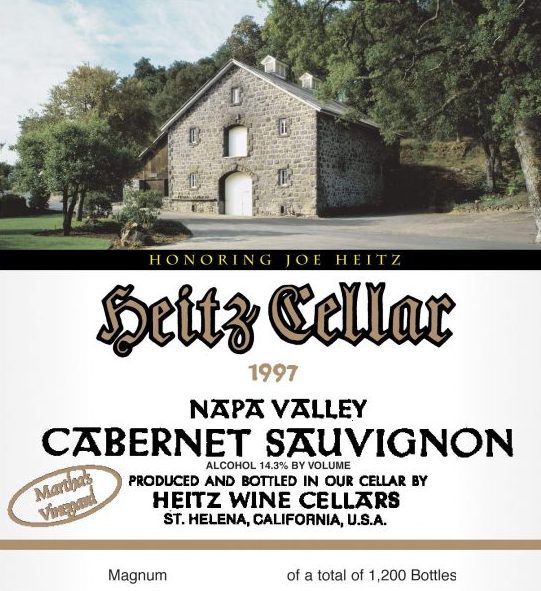
1998
1998 brought a cold and rainy weather pattern, called El Niño, creating a challenging year for winegrowers. With over sixty inches of rain in the four winter months, vines entered veraison as late in the year as most winemakers could recall. With such a late growing season there was considerable concern about mildew and botrytis during the overcast summer weeks. July gave up a few warm days, and August almost returned to normal warmth. The fact that the vines were carrying a light crop made everyone a little more patient. Fortunately, the first ten days of October brought the closest thing to a warm spell which was a much-needed relief to finish off ripening.
1998 Chardonnay Napa Valley
1998 Grignolino
1998 Grignolino Port
1998 Napa Valley Cabernet Sauvignon
1998 Bella Oaks Cabernet Sauvignon
1998 Trailside Vineyard Cabernet Sauvignon
1998 Martha’s Vineyard Cabernet Sauvignon
1998 NV Port
1999
After a winter of normal rainfall and somewhat lower than normal temperatures, budbreak was a little late, followed by late bloom and set, resulting in fewer and smaller clusters. After a wet spring, the long and cool months that followed were again the effects of El Niño. Fortunately, the last two weeks in September quickly warmed up and in response, most varieties tended to ripen at once.
1999 Chardonnay Napa Valley
1999 Grignolino
1999 Zinfandel
1999 Grignolino Port
1999 Napa Valley Cabernet Sauvignon
1999 Bella Oaks Cabernet Sauvignon
1999 Trailside Vineyard Cabernet Sauvignon
1999 Martha’s Vineyard Cabernet Sauvignon
1999 NV Port
2000
The legendary Joe Heitz passed away in December 2000. His contributions to the art and science of winemaking and production in the Napa Valley, and California as a whole, left a lasting impression on the industry and future generations of wine producers. His legacy was continued by the Heitz family and is still a part of the daily operations at the winery today.

2001
After late frosts and an unseasonably hot spring, the weather moderated, leading to an early harvest for many grapes and long hang times for others. And early bud break in March left vines vulnerable to a surprise frost in April, one of the most severe frosts in 25 years. Summer followed with the hottest May on record and the third hottest June, pushing harvest three weeks sooner than normal.
2001 Grignolino Rosé
2001 Chardonnay Napa Valley
2001 Chardonnay, “Cellar Selection”
2001 Zinfandel
2001 Grignolino
2001 Napa Valley Cabernet Sauvignon
2001 Bella Oaks Cabernet Sauvignon
2001 Trailside Vineyard Cabernet Sauvignon
2001 Martha’s Vineyard Cabernet Sauvignon
2001 NV Port
2002
A seven acre jewel nestled within the woods of Howell Mountain, Linda Falls Vineyard was acquired in 2002 and joined the Heitz Cellar estate. Planted near the gateway to the Linda Falls Preserve, Heitz Cellar donated an adjacent 21 acres to the Land Trust as an easement to the waterfall preserve and hiking trails.
Spring and summer in Napa Valley were just about perfect in 2002. A mild spring with no excessive heat to affect flowering, followed by a cool, steady August and dry, moderate autumn were the hallmarks of the optimal weather. Ripening was uniform: the cool and steady summer weather allowing long hang time and a development of flavors. Overall concentration of flavors and balance were the reward of an even growing year.
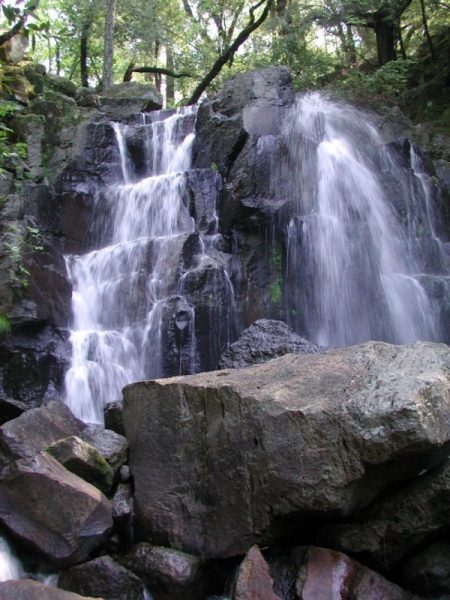
2002 Grignolino Rosé
2002 Chardonnay Napa Valley
2002 Chardonnay Cellar Selection
2002 Grignolino
2002 Zinfandel
2002 Napa Valley Cabernet Sauvignon
2002 Bella Oaks Cabernet Sauvignon
2002 Trailside Vineyard Cabernet Sauvignon
2002 Martha’s Vineyard Cabernet Sauvignon
2002 NV Port
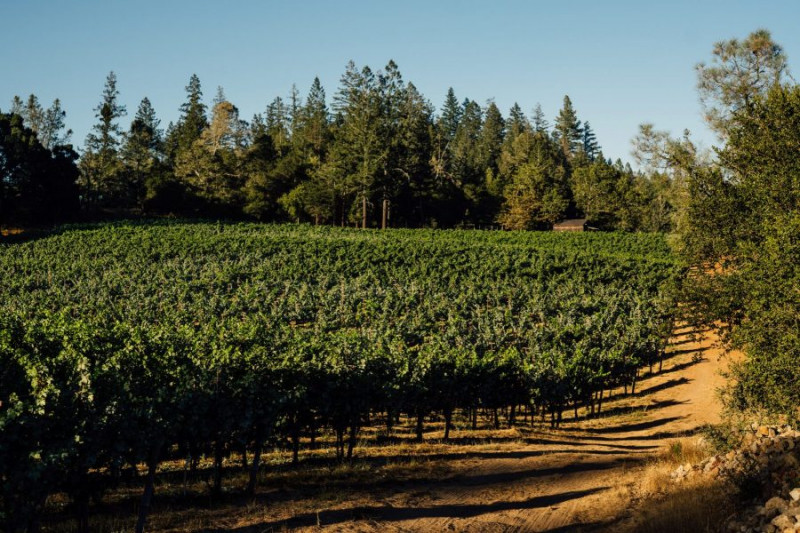
2003
As an improvement to cellar operations, the winery purchased a fully automated bottling line to not only increase efficiency but also to ensure the utmost quality at a crucial point in the life of a bottle of wine.
Warm February weather tricked the vines into early bud break, but it was immediately followed by an unseasonably cold and extremely wet April in which the vines virtually stopped growing for several weeks. May temperatures were closer to normal, and the vines resumed growth once again. The result was a slightly below average fruit set in Cabernet. It warmed up in June and there were some record-breaking heat waves, especially in July. August saw a return to average or below-average temperatures. After some rains in early September, a warm pattern set in around September, and the harvest was progressing at a steady pace.
2003 Chardonnay Napa Valley
2003 Grignolino Port
2003 Grignolino
2003 Zinfandel
2003 Napa Valley Cabernet Sauvignon
2003 Bella Oaks Cabernet Sauvignon
2003 Trailside Vineyard Cabernet Sauvignon
2003 Martha’s Vineyard Cabernet Sauvignon
2003 NV Port
2004
The growing season started quickly, with bloom coming almost a month earlier than in previous years. A record three-week hot spell in early March set the tone and pushed the vines. The spring weather continued to be warm, giving way to a cooler May and June. Cabernet Sauvignon went through veraison when the heat arrived in the last week of August and continued over the next two weeks, leading into one of the earliest harvests in Napa Valley.
2004 Grignolino Rosé
2004 Chardonnay Napa Valley
2004 Grignolino
2004 Zinfandel
2004 Grignolino Port
2004 Napa Valley Cabernet Sauvignon
2004 Bella Oaks Cabernet Sauvignon
2004 Trailside Vineyard Cabernet Sauvignon
2004 Martha’s Vineyard Cabernet Sauvignon
2004 NV Port
2005
With more infrastructure improvements to the winery, Heitz breathes new life into the cellar by replacing old tanks with new American oak upright tanks, ranging from 1,500 to 5,000 gallons, allowing flexibility in aging Cabernet Sauvignon lots separately.
A wet winter followed by rain in the spring and early summer created vigorous growth followed by a long, cool growing season and late harvest in most of California. The vine vigor contributed to larger than usual yields. The summer and early fall created a slow ripening season without major heat waves, contributing to excellent fruit quality with good sugar, flavors and ripe tannins, ending with a later than average start to harvest.
2005 Grignolino Rosé
2005 Grignolino
2005 Zinfandel
2005 Napa Valley Cabernet Sauvignon
2005 Bella Oaks Cabernet Sauvignon
2005 Trailside Vineyard Cabernet Sauvignon
2005 Martha’s Vineyard Cabernet Sauvignon
2005 NV Port
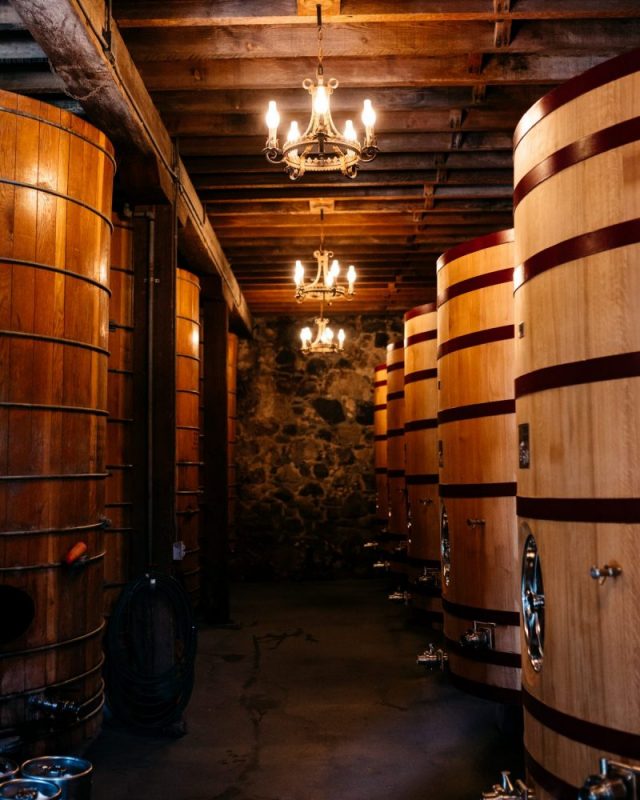
2006
A tumultuous year, with swings between flooding and a wet spring, to a record-setting heat wave in July, made 2006 a year for talented vineyard management. A cool down in August allowed grapes to ripen at a steadier pace, leading to a long harvest as different varieties were harvested at optimum ripeness.
2006 Grignolino Rosé
2006 Chardonnay
2006 Petit Verdot
2006 Zinfandel
2006 Grignolino
2006 Napa Valley Cabernet Sauvignon
2006 Bella Oaks Cabernet Sauvignon
2006 Trailside Vineyard Cabernet Sauvignon
2006 Martha’s Vineyard Cabernet Sauvignon
2006 NV Port
2007
The fourth and most recent commemorative label gracing Martha’s Vineyard Cabernet Sauvignon, dedicated to the May family, was chosen for the 2007 vintage. The next special label of the teens decade has yet to be revealed.
A dry winter with cold nights led to early budbreak Low rainfall continued throughout spring, and berry set was sparse. A mild, cool summer allowed the grapes to steadily develop flavor, while a mini heatwave late August/early September added a boost of sugar levels to complement the acid structure. Sporadic rains in early October made the harvest more challenging than expected, drawing it out into a more traditional timeframe.
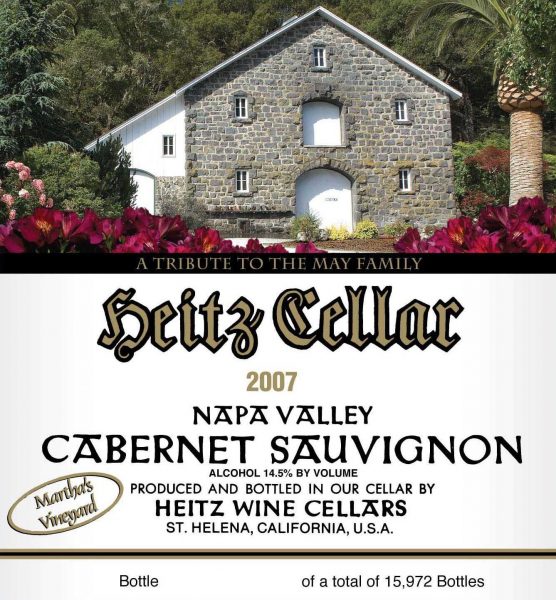
2007 Grignolino Rosé
2007 Sauvignon Blanc
2007 Chardonnay
2007 Zinfandel
2007 Napa Valley Cabernet Sauvignon
2007 Bella Oaks Cabernet Sauvignon
2007 Trailside Vineyard Cabernet Sauvignon
2007 Martha’s Vineyard Cabernet Sauvignon
2007 NV Port
2008
The 2008 growing season began as one of the driest springs on record, prompting vines to bud early, coinciding with a long period of deep frost, breaking records from mid-March to late April. Immediately following frost came an unseasonable heat spike as the vines were beginning to flower. Fortunately, the remainder of summer evened out with cooler and consistent temperatures. What looked like a steady harvest season was quickly shifted into high gear after a week-long heat wave over Labor Day, resulting in almost all varieties coming in at once.
2008 Sauvignon Blanc
2008 Grignolino Rosé
2008 Chardonnay
2008 Grignolino
2008 Zinfandel
2008 Napa Valley Cabernet Sauvignon
2008 Trailside Vineyard Cabernet Sauvignon
2008 Martha’s Vineyard Cabernet Sauvignon
2008 NV Port
2009
2009 was a much calmer season than 2008, with steady growth despite the third consecutive year of below normal precipitation. A mild summer gave way to a harvest with little worries, producing crops with evenly balanced tannins, fruit, and acidity.
2009 Sauvignon Blanc
2009 Grignolino Rosé
2009 Chardonnay
2009 Grignolino
2009 Zinfandel
2009 Napa Valley Cabernet Sauvignon
2009 Trailside Vineyard Cabernet Sauvignon
2009 Martha’s Vineyard Cabernet Sauvignon
2009 NV Port
2010
Rainfall returned after three dry years, delaying bud break but with no risk of frost. Spring and summer temperatures remained cool and even, with only one heat spike in late August. Harvest was later than usual because of the cooler weather, but the longer hang time allowed grapes to achieve full maturity with good color and flavor development.
2010 Grignolino Rosé
2010 Sauvignon Blanc
2010 Chardonnay
2010 Grignolino
2010 Zinfandel
2010 Napa Valley Cabernet Sauvignon
2010 Trailside Vineyard Cabernet Sauvignon
2010 Martha’s Vineyard Cabernet Sauvignon
2010 NV Port
2011
An important milestone for Heitz Cellar as the family celebrated their 50th Anniversary of the founding in 1961.
For a second consecutive vintage, Napa Valley dealt with uncharacteristically cool, wet conditions in 2011. With a several week stall in bud break and flowering, followed by more rain in June, vines were delayed in their normal growth pattern. One of the latest starts to harvest in memory brought in a variety of yields, depending on which vineyards experienced ‘shatter’ from the June rains. Overall quantity was low, but the quality of fruit was well structured and balanced. A challenging vintage throughout Napa Valley, Heitz Cellar did not bottle a 2011 Martha’s Vineyard or Trailside Vineyard Cabernet Sauvignon this year in order to preserve the uncompromising quality standard set for these wines.
2011 Chardonnay
2011 Sauvignon Blanc
2011 Grignolino Rosé
2011 Napa Valley Cabernet Sauvignon
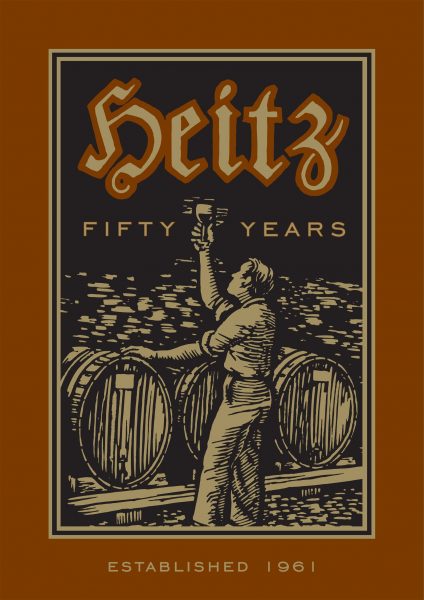
2012
Brittany Sherwood joined the Heitz Cellar winemaking team as a harvest intern on the heels of international winemaking internships following her graduation from UC Davis.
No growing season is easy, but 2012 presented few challenges. “Classic” and “textbook” are terms used to describe this perfect growing year. A mild spring led to a good fruit set and summer and fall brought warm temperatures, but no heat waves. All the fruit enjoyed a long, slow ripening and crops yields were abundant. Optimum ripeness and excellent quality fruit at harvest translates to high quality wines with balanced components in the bottle.
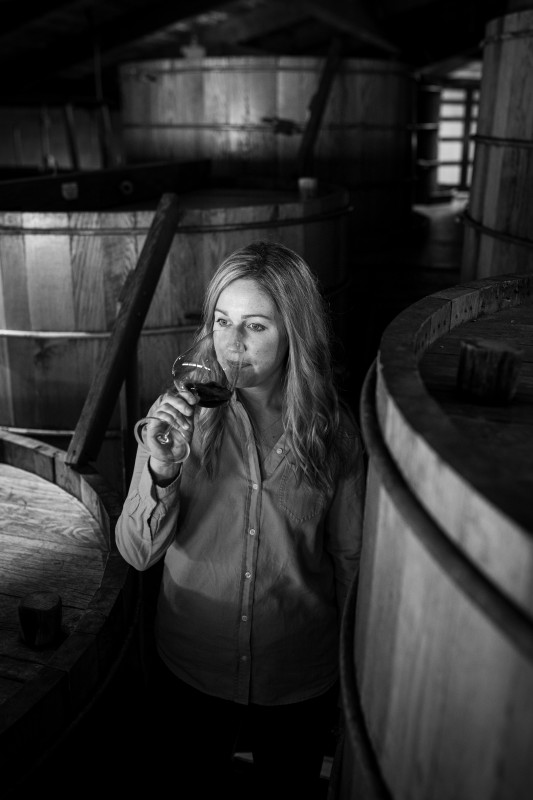
2012 Sauvignon Blanc
2012 Grignolino Rosé
2012 Chardonnay
2012 Grignolino
2012 Zinfandel
2012 Napa Valley Cabernet Sauvignon
2012 Trailside Vineyard Cabernet Sauvignon
2012 Martha’s Vineyard Cabernet Sauvignon
2012 NV Port
2013
Recognizing that the Cabernet Sauvignon made from the Linda Falls Vineyard was remarkable enough to stand on its own, 2013 marked the first vintage as its own bottling, making Heitz Cellar’s single vineyard collection a perfect trio.
A warm, dry spring allowed for early bud break but thanks to temperate weather, the fruit was not in danger of frost or rain damage. Consistently warm summer months trailed into early fall, uninterrupted by heat spikes or rain, which made for an early harvest in ideal conditions, ending about two weeks earlier than usual.
2013 Grignolino Rosé
2013 Sauvignon Blanc
2013 Chardonnay
2013 Grignolino
2013 Zinfandel
2013 Napa Valley Cabernet Sauvignon
2013 Trailside Vineyard Cabernet Sauvignon
2013 Martha’s Vineyard Cabernet Sauvignon
2013 Linda Falls Vineyard Cabernet Sauvignon
2013 NV Port
2014
2014 will be remembered as the year a powerful earthquake rocked Napa Valley in late August. It was also the second in a series of drought vintages, making for an accelerated growing season, which began with early flowering after a mild winter and culminated in an exceptionally early start to harvest. The summer remained steadily warm, largely uninterrupted by the heat spikes. Thanks to those cool conditions, the wines have retained fresh fruit and bright acidities.
2014 Sauvignon Blanc
2014 Grignolino Rosé
2014 Chardonnay
2014 Grignolino
2014 Zinfandel
2014 Napa Valley Cabernet Sauvignon
2014 Linda Falls Vineyard Cabernet Sauvignon
2014 Martha’s Vineyard Cabernet Sauvignon
2014 Trailside Vineyard Cabernet Sauvignon
2015
The fourth drought-influenced year in a row, plus a cold spell in May during flowering led to uneven fruit set and significantly lower yields compared to the three previous vintages. The smaller crop ripened quickly though, with picking beginning in August and ending by mid-October.
2015 Sauvignon Blanc
2015 Grignolino Rosé
2015 Zinfandel
2015 Chardonnay
2015 Grignolino
2015 Napa Valley Vineyard Cabernet Sauvignon
2015 Martha’s Vineyard Cabernet Sauvignon
2015 Trailside Vineyard Cabernet Sauvignon
2015 Linda Falls Vineyard Cabernet Sauvignon
2016
The final drought-influenced vintage since 2012, the growing season started early and continued on a steady pace throughout the ideal weather of summer, without serious heat spikes. An increase in temperature at the end of the growing season allowed grapes to achieve perfect ripeness and phenolic maturity, without the stress of inclement weather.
2016 Sauvignon Blanc
2016 Grignolino Rosé
2016 Chardonnay
2016 Lot C-91
2016 Napa Valley Cabernet Sauvignon
2016 Martha’s Vineyard Cabernet Sauvignon
2016 Trailside Vineyard Cabernet Sauvignon
2016 Linda Falls Vineyard Cabernet Sauvignon
2017
The five-year drought was relieved over the winter, with abundant rainfall followed by a mild spring. An even summer with normal temperatures allowed for healthy vines with even growth and full veraison. The growing season turned hot in early September, accelerating harvest into high gear, with no cooling-off period. October 8 was the start of a raging wildfire across Napa Valley, sending wineries and growers into a tailspin, concerned about safety, vineyard and winery survival, and mostly, the condition of our overall community.
2017 Sauvignon Blanc
2017 Chardonnay
2017 Grignolino Rosé
2017 Lot C-91
2017 Napa Valley Cabernet Sauvignon
2017 Martha’s Vineyard Cabernet Sauvignon
2017 Trailside Vineyard Cabernet Sauvignon
2017 Linda Falls Vineyard Cabernet Sauvignon
2018
A monumental year in the history of Heitz Cellar; the Heitz family gracefully retired after 57 years of winemaking and passed their rich legacy into the hands of the Lawrence family in April, 2018. Under the new family ownership, a commitment to preserving all that Heitz Cellar has achieved, and renewing its place in the wine world, is the focused vision.
Early 2018 delivered abundant rains with bud break and flowering a bit later than usual, but with ideal weather. A plentiful and even fruit set was followed by a sunny summer, kept in check by marine fog influence. Moderate heat continued into fall, leading to a gradual, even ripening. Crop yields were larger than average, and harvest started and ended on a normal timeline.

2018 Sauvignon Blanc
2018 Quartz Creek Chardonnay
2018 Grignolino Rosé
2018 Lot C-91
2018 Martha’s Vineyard Cabernet Sauvignon
2018 Trailside Vineyard Cabernet Sauvignon
2018 Linda Falls Vineyard Cabernet Sauvignon
2018 Napa Valley Cabernet Sauvignon
2019
2019 began with abundant winter rainfall, allowing the soils to maintain late soil moisture, giving the vines a fantastic start to the growing season. The long, warm summer was even and consistent and marked by the classic, cool foggy mornings that help our vineyards maintain their vibrant and expressive characteristics. Overall, the incredible growing season led to wines with bright acidity, great structure with soft tannins, and brilliant, distinct aromatics. The 2019 vintage will be remembered as another wonderful growing season in Napa Valley.
2019 Quartz Creek Chardonnay
2019 Napa Valley Cabernet Sauvignon
2019 Lot C-91
Additional 2019 wines will be released following their unique aging regime.
2020
Rains arrived at the end of March after a warm, dry winter. The mild spring gave way to cool mornings and warm days however the excellent growing conditions and harvest were stalled by two wildfires. Our commitment to quality led us to the decision to cease harvesting after the first fire started on August 17th. As Heitz Cellar naturally picks early, we had brought in about 1/15th of our normal Cabernet Sauvignon harvest by this point. This will be a highly allocated vintage due to the quantity, but the quality of the wine is distinct for its vibrancy and freshness, a snapshot of what was on track to be a great vintage.
2020 Quartz Creek Chardonnay
Additional 2020 wines will be released following their unique aging regime.
2021
A second consecutive year of dry weather lent itself to an incredible vintage in Napa Valley. Abundant sunshine followed by cool evenings led to a smooth and uneventful harvest season. Low yields produced a concentrated crop with intense flavors.
2021 Quartz Creek Chardonnay
2021 Lot C-91 Blanc
Additional 2021 wines will be released following their unique aging regime.
2022
We had a relatively early start to the season and picked well ahead of the heat wave that marked the 2022 vintage in early September. The wines from this vintage are indicative of great growing season.
2022 Quartz Creek Chardonnay
2022 Lot C-91 Blanc
Additional 2022 wines will be released following their unique aging regime.


